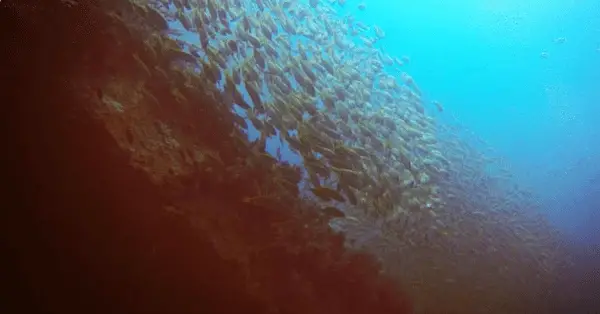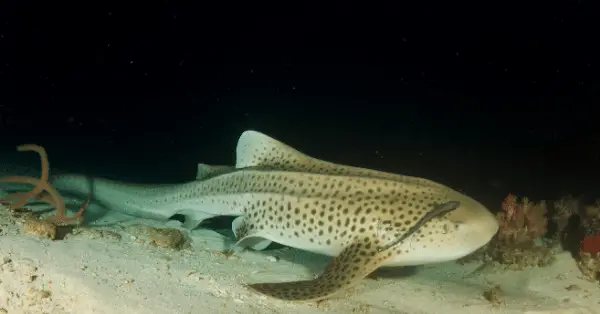The dive plan for the King Cruiser Shipwreck in Phuket and Phi Phi
The MS King Cruiser wreck is one of the most popular dive sites in Phuket, and the most known shipwreck in the area.
The King Cruiser was a car ferry operating between Phuket and Phi Phi until 1997 and is now an artificial dive site for scuba divers from Phi Phi and Phuket alike.

The vessel has now been transformed into an entertaining scuba diving spot and serves as an artificial reef as an extension of the Anemone Reef. Lying on the sandy bottom of 98 feet (30 meters), it can be explored at depths ranging from 60 feet (18 meters).
The dive site is located near Shark Point, and is often combined with the reef and the pinnacles.
King Cruiser wreck dive site brief
- Access: From boat
- Maximum depth: 108 feet/ 33 meters
- Visibility: 16 – 98 feet / 5 – 30 meters
- Dive time: 45 minutes
- Certification level: Advanced Open Water
- Current: medium to strong
- Type: shipwreck, deep dive; nitrox
History of the King Cruiser Wreck in Phuket & Phi Phi
On May 4, 1997, the MS King Cruiser tragically sank off Thailand’s West Coast. This car ferry had been a mainstay for tourists and locals alike since its launch in 1969.
On a trip from Phuket to Phi Phi Islands, the ferry hit an underwater set of rocky pinnacles near Anemone Reef and became damaged beyond repair. Within two and a half hours, it had sunk completely – yet all 561 passengers were saved in time! Police patrol boats as well as several fishing vessels responded to the emergency call for help immediately, rescuing both Thai nationals and foreign tourists aboard.
Under great conditions, the ferry glided along its customary route through Anemone Reef – a region that was no stranger to these experienced captains. Nevertheless, despite this knowledge of what to expect in the region, a mishap still took place and left people questioning why it occurred. Consequently, there have been several baseless ideas as to what may have caused the accident.

About the King Cruiser car ferry
The ship’s size is 279 feet (85 meters) long, 82 feet (25 meters) wide, and has a height of approximately 100-ish feet (30 meters).
In the last two decades, this wreck has sadly deteriorated yet become a vibrant artificial reef that supports an abundance of aquatic life.
In 2003, the highest deck of the stern caved in, thus making it unsafe for anyone to enter. Previously, the shallowest part was close to 33 feet (10 meters), but due to its deteriorated condition, the tallest parts have collapsed. Besides the collapsed upper deck, the wreck remains largely in one piece.
Now, the wreck starts at 60 feet/18 meters.

Dive plan for the King Cruiser wreck
Divers usually use the mooring line in the north of the wreck down to about 59 to 72 feet (18 – 22 meters) to explore the bow and passenger deck level.
From there, divers swim around the wreck and explore the vessel as well as the marine life that calls the MS King Cruiser now its home.
On the deck level are many swim through opportunities, however, divers need to be aware of sharp objects and potentially collapsing structures. Additionally, camouflage scorpionfish might feel interrupted and could attack divers.
You can descend further and dive along the hull at depths of up to 108 feet (33 meters) on the high tide (98 ft/30 m on low tide). The average dive depth is usually between 72 and 85 feet (22 – 26 meters).
Reaching the south-end of the King Cruiser is the stern and car ramp. Above, at 60 feet (18 meters), lies the collapsed foredeck which is usually populated by snappers. The upper deck splits in half, providing more exciting exploration opportunities for divers.
On the ascent, you can explore the wheelhouse at the wreck’s peak and the highest point at 60 feet (18 meters).
Depending on the air consumption and the current, divers may not conduct the safety stop at the mooring line. Therefore, it’s important to stay together and fight the current during the safety stop and to use an inflatable diver down warning signal. Because of the dive site’s popularity and various exit points, there can be heavy boat traffic. Be extra cautious at the King Cruiser shipwreck dive site in Phuket.
Can divers explore the inside of the King Cruiser wreck?
For a secure, straightforward point of access, dive into the stern and traverse through the car decks. You’ll find machinery on deck, while inside are vehicle tires and an engine trolley. Furthermore, you can find passenger seats, as well as coffee tables, occupying its innermost crevices.
Nitrox diving at the King Cruiser wreck
If you are Nitrox trained, you should consider taking an EAN32 tank on this dive. It will give you just enough extra time to explore the shipwreck in more detail. It’s also a great Nitrox practice location.

What’s to see at the King Cruiser shipwreck in Phuket & Phi Phi
A beautiful array of marine life awaits you at the wreck site with vibrant soft corals, schools of bigeye trevally, and yellow snapper congregating near the car deck’s entrance and upper deck remains. Look out for other spectacular sea creatures such as Thailand zebra sharks, bamboo sharks, barracuda, and turtles. During the migration season, it could be possible to spot a whale shark.
When is the best time to dive the King Cruiser shipwreck?
If you’re looking for the perfect underwater experience, then dive at King Cruiser shipwreck between November to April when conditions are ideal with sunny skies and superb visibility. The monsoon season – from May through October -brings strong winds and heavy downpours that can make your dive less pleasant or even impossible. The winter months also increase your chances to see migrating animals like whale sharks or mantas.
What certification is required to dive at King Cruiser wreck?
Only Advanced Open Water divers should take on the King Cruiser wreck dive due to its depth. It is essential to be aware of the current intensity as well, so if you haven’t yet reached an advanced certification level, it would be wise to consult with a professional diver before attempting this dive.
Related dive sites
Phuket is home to over 7 shipwrecks, most of which are located at Racha Island, specifically at the Scuba Park of Bay 1 and 2.
If you are interested in seeing sharks or other bigger animals, Marina Bay & Maritas Rock are great for sharks. Racha Noi South Tip is famous for manta rays.







